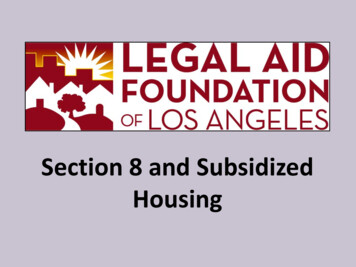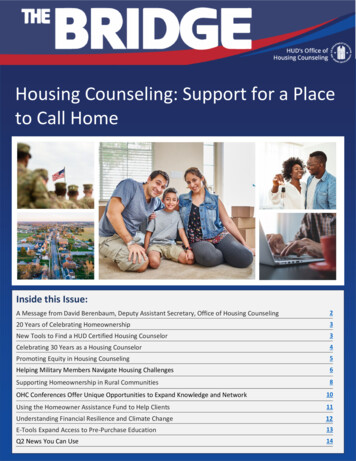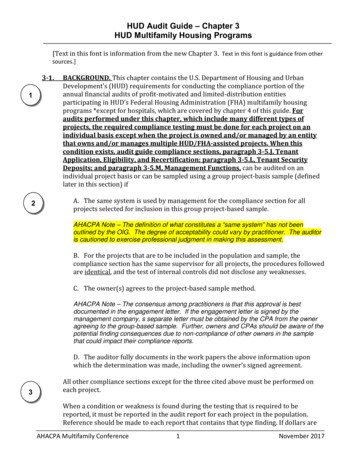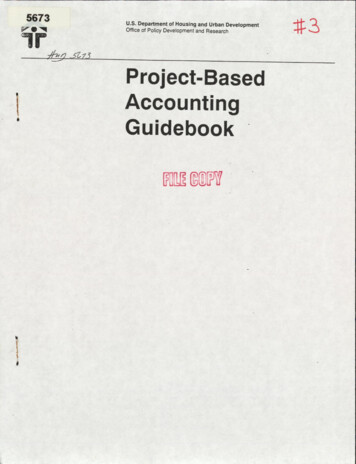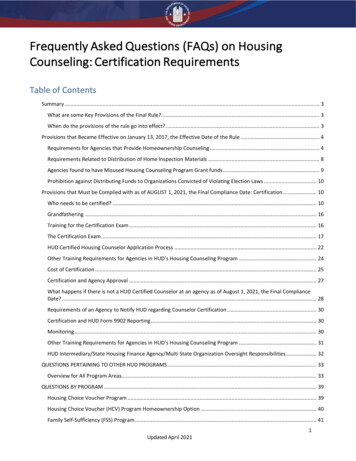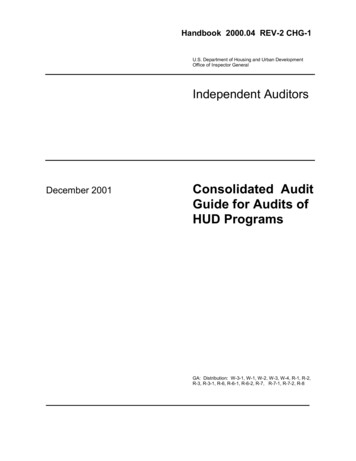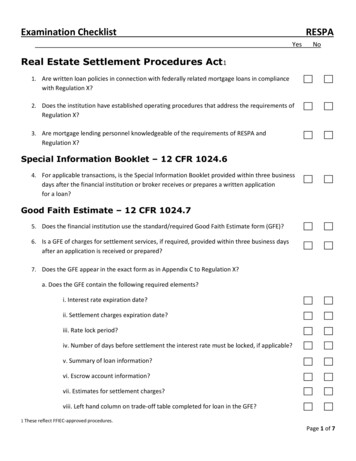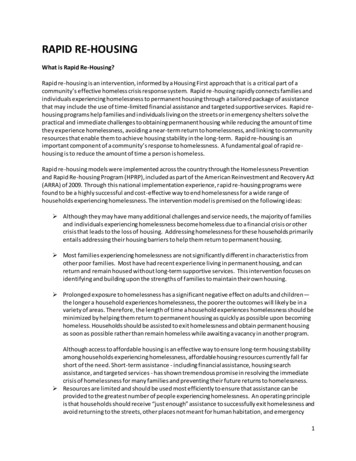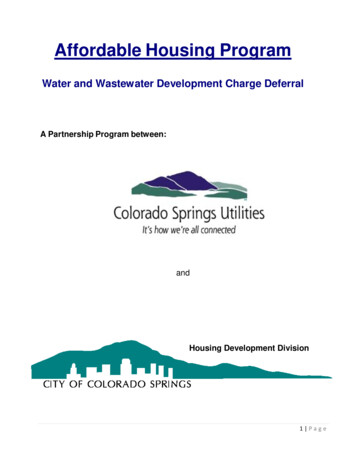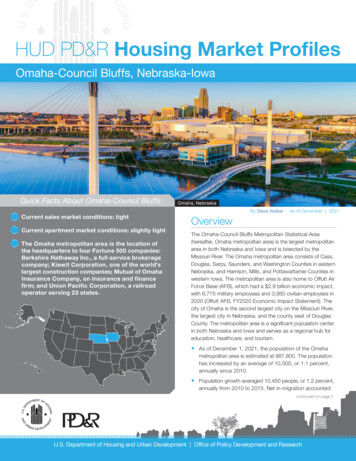
Transcription
HUD PD&R Housing Market ProfilesOmaha-Council Bluffs, Nebraska-IowaQuick Facts About Omaha-Council BluffsCurrent sales market conditions: tightCurrent apartment market conditions: slightly tightThe Omaha metropolitan area is the location ofthe headquarters to four Fortune 500 companies:Berkshire Hathaway Inc., a full-service brokeragecompany; Kiewit Corporation, one of the world’slargest construction companies; Mutual of OmahaInsurance Company, an insurance and financefirm; and Union Pacific Corporation, a railroadoperator serving 23 states.Omaha, NebraskaBy Steve Walker As of December 1, 2021OverviewThe Omaha-Council Bluffs Metropolitan Statistical Area(hereafter, Omaha metropolitan area) is the largest metropolitanarea in both Nebraska and Iowa and is bisected by theMissouri River. The Omaha metropolitan area consists of Cass,Douglas, Sarpy, Saunders, and Washington Counties in easternNebraska, and Harrison, Mills, and Pottawattamie Counties inwestern Iowa. The metropolitan area is also home to Offutt AirForce Base (AFB), which had a 2.9 billion economic impact,with 6,775 military employees and 3,950 civilian employees in2020 (Offutt AFB, FY2020 Economic Impact Statement). Thecity of Omaha is the second largest city on the Missouri River,the largest city in Nebraska, and the county seat of DouglasCounty. The metropolitan area is a significant population centerin both Nebraska and Iowa and serves as a regional hub foreducation, healthcare, and tourism.y As of December 1, 2021, the population of the Omahametropolitan area is estimated at 987,800. The populationhas increased by an average of 10,500, or 1.1 percent,annually since 2010.y Population growth averaged 10,450 people, or 1.2 percent,annually from 2010 to 2015. Net in-migration accountedcontinued on page 2U.S. Department of Housing and Urban Development Office of Policy Development and Research
2HUD PD&R Housing Market ProfilesOmaha-Council Bluffs, Nebraska-IowaAs of December 1, 2021continued from page 1for 3,750 people annually, or 36 percent of the growth,whereas net natural change (resident births minus residentdeaths) accounted for 6,700 people annually, or 64 percent(Census Bureau population estimates as of July 1). Since2015, population growth has averaged 10,500 people, or1.1 percent, annually. Net in-migration accounted for 4,400people, or 42 percent of the growth, whereas net naturalchange accounted for 6,100 people annually, or 58 percent(current estimates by the analyst).y Individuals aged 60 years and older represent an increasingshare of the population in the Omaha metropolitan area. Thisage cohort increased from 18 percent of the population in2010 to 20 percent of the total population in 2019 (AmericanCommunity Survey [ACS] 1-year data). The 40–59-age cohortdeclined the most during this period, from 26 percent in 2010to 24 percent in 2019.y Douglas County accounted for 82 percent of populationgrowth in the metropolitan area from 2010 to 2019, followedby Sarpy County, with 17 percent, and Cass, Saunders, andWalker Counties, with 1 percent each. The populations inHarrison, Mills, and Pottawattamie Counties each declinedduring this period.Economic ConditionsThe economy of the Omaha metropolitan area is recoveringafter a short, but severe, recession early in 2020 caused bypublic health measures put in place to slow the spread ofCOVID-19. Job recovery occurred during the past year asrestrictions on businesses were gradually lifted, and peoplereturned to work. Economic conditions in the metropolitan areaare currently recovering, following the sharp jobs decline duringthe recession in March and April 2020 when nonfarm payrolls inthe metropolitan area declined by 45,300 jobs, or 9.0 percent.In November 2021, the Omaha metropolitan area regained allof the jobs lost (monthly data, not seasonally adjusted).Nonfarm payrolls increased to an average of 500,900 jobsduring the 3 months ending November 2021, an increaseof 13,000 jobs, or 2.7 percent, from the 3 months endingNovember 2020. Nonfarm payrolls in Nebraska grew at asimilar rate, increasing 2.9 percent, whereas nonfarm payrollsin the nation grew at a much faster pace, increasing 4.1 percent.Job growth was relatively faster for the nation as a whole,partly because the effect of the COVID-19 pandemic on jobcounts was more severe nationwide compared with the Omahametropolitan area.During the 3 months ending November 2021—y The largest payroll gains in numeric and percentage termsoccurred in the leisure and hospitality sector, which added5,600 jobs, or 12.7 percent, compared with a year ago, to49,700 jobs; despite these gains, sector payrolls remain4.6 percent below levels during the 3 months endingNovember 2019, before the pandemic.y The wholesale and retail trade sector added 1,800 jobs,or 2.7 percent, compared with a year earlier, as shopperscontinued on page 3In the Omaha metropolitan area, 10 out of 11 sectors gained jobs during the 3 months ending November 2021.3 Months EndingNovember 2020(Thousands)Total Nonfarm PayrollsGoods-Producing SectorsMining, Logging, & ConstructionManufacturingService-Providing SectorsWholesale & Retail TradeTransportation & UtilitiesInformationFinancial ActivitiesProfessional & Business ServicesEducation & Health ServicesLeisure & HospitalityOther ServicesGovernmentUnemployment 4.117.865.73.7%Year-Over-Year ChangeNovember 0.50.30.92.92.72.83.1-3.14.01.812.75.10.8Note: Numbers may not add to totals due to rounding.Source: U.S. Bureau of Labor StatisticsU.S. Department of Housing and Urban Development Office of Policy Development and Research
3HUD PD&R Housing Market ProfilesOmaha-Council Bluffs, Nebraska-IowaAs of December 1, 2021continued from page 2Several ongoing projects in the metropolitan area have thepotential to positively impact job growth in the leisure andhospitality sector. The 300 million Riverfront Revitalizationproject, spanning the cities of both Omaha and Council Bluffs,is a redevelopment of the waterfront area with parks, retailbusinesses, and restaurants on both sides of the Missouri River;it is expected to be complete in 2024. The Crossroads is amixed-used development being built on the site of the formerCrossroads Mall that closed in 2008, and it is also slated to Nov2016Nov2015NovNoNov20142013-8.0vThe leisure and hospitality sector accounts for approximately10 percent of all nonfarm payroll jobs in the metropolitanarea. The sector, which relies heavily on tourism, contractedduring 2020 because of countermeasures implemented toslow the spread of COVID-19. The city of Omaha has playedhost to the National Collegiate Athletic Association (NCAA)Men’s College World Series (CWS) since 1950. The value ofthe CWS to the Omaha economy has grown considerably. Astudy conducted by Creighton University found that the eventhad an economic impact of 88.3 million on the metropolitanarea and supported 1,100 year-round jobs in 2019, up from 63.7 million and 777 jobs in 2014. The CWS, which attractedapproximately 332,000 visitors in 2019, has the greatest impacton bars, restaurants, hotels, recreation, and entertainmentestablishments. For bars and restaurants alone, the 2019CWS contributed 6.5 million in wages.4.020121.6 percent from 3.7 percent a year earlier. By comparison,the unemployment rate for the nation averaged 3.7 percent,down from 6.5 percent a year earlier.6.0Noy The unemployment rate in the metropolitan area decreased toOmaha Metropolitan AreaNebraskaNationvjobs, or 1.8 percent, compared with the 3 months endingNovember 2020. The education and health services sectoris the largest sector in the metropolitan area, accountingfor approximately 16 percent of all nonfarm payrolls.Noy The education and health services sector added 1,400During the 3 months ending November 2021, nonfarmpayrolls in the Omaha metropolitan area grew at aslower rate than the nation and the state of Nebraska.Percentage Change from Previous Year(3-Month Average)began to visit stores again after a period of hesitancybecause of concerns about the spread of COVID-19.Source: U.S. Bureau of Labor StatisticsLargest Employers in the Omaha Metropolitan AreaNumber ofEmployeesName of EmployerNonfarm Payroll SectorOffutt Air Force BaseGovernmentNebraska MedicineEducation &Health Services9,500CHI HealthEducation &Health Services9,00010,725Notes: Excludes local school districts. Data includes military personnel, who aregenerally not included in nonfarm payroll survey data.Source: Omaha Chamber of Commercecomplete in 2024. The proposed 40-acre development will include1.5 million square feet of newly built retail businesses, restaurants,entertainment venues, offices, apartments, and condominiums.Heartwood Preserve, currently under construction, is a 500-acremixed-use development in the city of Omaha that will include retailspace, restaurants, office space, condominiums, apartments,senior apartments, parks, and open space upon completion.Sales Market ConditionsThe sales housing market in the Omaha metropolitan area iscurrently tight, with an estimated vacancy rate of 1.0 percent,down from 1.9 percent in 2010 when the market was soft. Inconjunction with strong population and economic growth beforethe pandemic, a limited supply of for-sale inventory contributedto the decline in the vacancy rate. The sales market remainedrelatively strong through the brief economic downturn in 2020;however, there was an uptick in the share of mortgages thatwere seriously delinquent (90 or more days delinquent or inforeclosure) or in real estate owned (REO) status. The shareof mortgages that were seriously delinquent or in REO statusincreased from 1.0 percent in November 2019 to 2.9 percentin November 2020 (CoreLogic, Inc.). Since then, the rate hasdeclined to 1.5 percent in the metropolitan area as of November2021, equal to the rate for Nebraska, but below the 2.1-percentrate for the nation.During the 12 months ending November 2021—y New home sales totaled 2,450, down 5 percent fromthe 2,575 sales a year ago (CoreLogic, Inc.). The recentcontinued on page 4U.S. Department of Housing and Urban Development Office of Policy Development and Research
HUD PD&R Housing Market Profiles4Omaha-Council Bluffs, Nebraska-IowaAs of December 1, 2021continued from page 3decrease—caused largely by supply-chain issues—ended a 2-year period of increasing sales. New homesales accounted for 10 percent of all home sales in themetropolitan area during the past 12 months.y Single-family construction activity averaged 2,600 homesannually from 2010 through 2015; construction activitythen increased to an average of 3,000 homes annually from2016 through 2020. Homebuilding in the metropolitan areacontinued on page 5y The average sales price for a new home was 364,500, up9 percent from a year earlier. Low levels of for-sale inventorycontributed to rising home sales prices.Home sales growth in the Omaha metropolitan areahas slowed since early 2021.y Existing home sales totaled 22,200, up 3 percent from theNew Home Sales21,450 homes sold during the previous 12-month period.y During the 12 months ending November 2021, the numberof single-family homes permitted totaled 3,675, decliningby 225 homes, or 6 percent, from the previous 12 months(preliminary data). Approximately 1,400 single-family homesare currently under construction.Since 2020, the average price of existing homesin the Omaha metropolitan area increased morerapidly than the average new home sales price.100-10-20-30Note: Sales are for single-family homes, townhomes, and condominiums.Source: CoreLogic, Inc.The proportion of seriously delinquent home loansand REO properties in the Omaha metropolitan arearose sharply in mid-2020 following more than8 years of steady declines.Omaha Metropolitan AreaExisting Home Sales Prices12Home Loans that Were 90 or MoreDays Delinquent, in Foreclosure,or in REO Status (%)1086420-27654321Note: Prices are for single-family homes, townhomes, and condominiums.Source: CoreLogic, Inc.20No 11v20No 12v20No 13v20No 14v20No 15v20No 16v20No 17v20No 18v20No 19v20No 20v2021Nov2012v20No 13v20No 14v20No 15v20No 16v20No 17v20No 18v20No 19v20No 20v2021NovvNation0NoNoNebraska82011Percentage Change from Previous Year(12-Month Average)New Home Sales Prices2020No 11v20No 12v20No 13v20No 14v20No 15v20No 16v20No 17v20No 18v20No 19v20No 20v2021Single-family homebuilding in the metropolitan area—asmeasured by the number of single-family homes permitted—increased during the 12 months ending November 2021. In thepast 3 years, 47 percent of all new home construction in themetropolitan area occurred in Douglas County, followed by35 percent in Sarpy County—home to Offutt AFB—althoughSarpy County has only accounted for 17 percent of thepopulation growth since 2010.30Novan increase of 11 percent from 206,700 a year earlier.Sales prices increased significantly due to limited inventoryand relatively strong in-migration.Percentage Change from Previous Year(12 Months Ending)y The average sales price for existing homes was 228,600,Existing Home Sales40REO real estate owned.Source: CoreLogic, Inc.U.S. Department of Housing and Urban Development Office of Policy Development and Research
5HUD PD&R Housing Market ProfilesOmaha-Council Bluffs, Nebraska-IowaAs of December 1, 2021continued from page 4has been relatively steady during this period, with a high ofapproximately 3,500 homes permitted in 2020.Since 2012, single-family home construction has beenrelatively steady in the Omaha metropolitan area.y Lakeview, a 194-home subdivision which began constructionSingle-Family HomesSingle-Family Homes 1Single-Family Homes Permittedin 2019 in Sarpy County, has 10 lots available, with homeprices starting at 350,000.12ME 12 months ending.Sources: U.S. Census Bureau, Building Permits Survey; 2000–2020 final data andestimates by the analyst; past 24 months of data—preliminary data and estimatesby the analystApartment Market Conditionsthe metropolitan area during the past year. The lowestapartment vacancy rate was in the Moody’s Analytics REISdefined North Omaha market area, home of Eppley Airfield,at 3.0 percent, down from 5.0 percent from a year ago. TheSarpy County and Southwest Omaha market areas had thehighest rates, at 6.0 and 5.0 percent, respectively; both hadvacancy rates of 5.0 percent a year ago. The South Omahamarket area had a vacancy rate of 4.0 percent, down from7.0 percent a year ago.y The average rent for apartments in the Omaha metropolitanarea was 1,074, an increase of 14 percent from 945during the fourth quarter of 2021, after increases averagingapproximately 4 percent a year from 2010 through 2019.101291088766452403-22Vacancy Rate (%)Vacancy 4Q2021y Vacancy rates decreased in 3 out of 4 submarkets inYoY Percentage Change in Asking Rent144QDuring the fourth quarter of 2021—Since the fourth quarter of 2020, rents in the Omahametropolitan area have risen sharply, and the vacancyrate has fallen.Year-Over-Year PercentageChange in Asking RentThe apartment market in the Omaha metropolitan area isslightly tight compared with balanced conditions a year earlier.During the fourth quarter of 2021, the average apartmentvacancy rate was 4.6 percent—down from 5.5 percent duringthe fourth quarter of 2020 (Moody’s Analytics REIS). Strongrenter household growth kept the apartment vacancy rate lowduring the early to mid-2010s. Vacancy rates slowly trendedupwards during the mid-to-late 2010s as new units were addedto the market. Rising home prices, a reviving economy, anda slowdown in apartment construction during 2020 led to aslightly tight apartment market with rapidly increasing rents.4Q fourth quarter. YoY year-over-year.Source: Moody’s Analytics REISy By bedroom size, average rents in the Omaha metropolitanarea were 807, 918, 1,214, and 1,503 for studio, one-,two-, and three-bedroom units, representing respectiveincreases of 9, 11, 17, and 11 percent from a year ago.y Significant rent growth occurred in all market areas comparedwith a year ago. The largest increase was 15 percent in thecontinued on page 6U.S. Department of Housing and Urban Development Office of Policy Development and Research
6HUD PD&R Housing Market ProfilesOmaha-Council Bluffs, Nebraska-IowaAs of December 1, 2021continued from page 5y During the 12 months ending November 2021, 2,725multifamily units were permitted in the Omaha metropolitanarea, up 49 percent from 1,825 units permitted during the12 months ending November 2020 (preliminary data).y An average of 2,175 multifamily units were permitted eachyear from 2016 through 2020, when net in-migrationincreased in the metropolitan area, higher than an average ofonly 1,475 units permitted each year from 2010 through 2015.y An estimated 2,600 multifamily units are currently underconstruction in the metropolitan area; approximately 65 percentof them are in Douglas County, with approximately 30 percent inSarpy County and the remaining units in Pottawattamie County.Multifamily UnitsMultifamily Units 0162017201820191220M20ENo12v20ME20Nov2021After reaching a recent high in 2017, multifamily constructionactivity, as measured by the number of units permitted, declinedthrough 2019 before picking up again in 2020. To date, 2021is on track to have the highest number of multifamily unitspermitted in the past 10 years.In the Omaha metropolitan area, 2021 is on trackto have the highest number of multifamily unitspermitted in the past 10 years.Multifamily Units PermittedNorth Omaha market area, where the average rent rose to 1,045. The smallest increase occurred in the South Omahamarket area, where the average rent rose 11 percent to 1,085. The remaining two markets, the Sarpy Countyand Southwest Omaha areas, had increases of 12 and14 percent, where average rents were 1,085 and 1,076, respectively.12ME 12 months ending.Sources: U.S. Census Bureau, Building Permits Survey; 2000–2020 final data andestimates by the analyst; past 24 months of data—preliminary data and estimatesby the analysty Completed in June 2021, the Edge 204 apartments is a new176-unit development in the city of Elkhorn. Asking rentsstart at 999, 1,150, 1,275, and 1,650 for studio-, one-,two-, and three-bedroom units, respectively.U.S. Department of Housing and Urban Development Office of Policy Development and Research
city of Omaha is the second largest city on the Missouri River, the largest city in Nebraska, and the county seat of Douglas County. The metropolitan area is a significant population center in both Nebraska and Iowa and serves as a regional hub for education, healthcare, and tourism. y. As of December 1, 2021, the population of the Omaha
